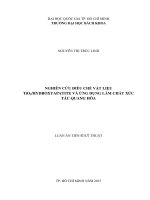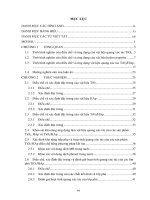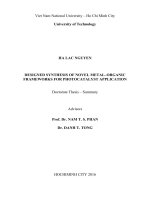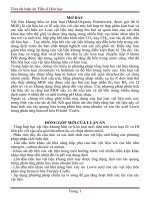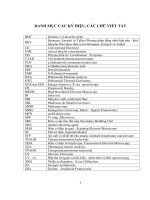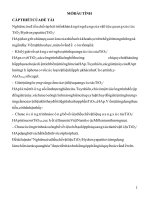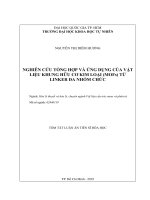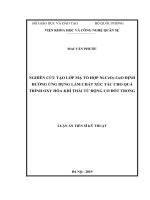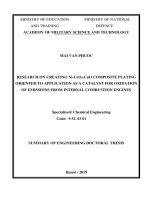Thiết kết tổng hợp vật liệu khung hữu cơ kim loại mới định hướng ứng dụng làm chất xúc tác quang hoá (tóm tắt)
Bạn đang xem bản rút gọn của tài liệu. Xem và tải ngay bản đầy đủ của tài liệu tại đây (647.04 KB, 27 trang )
Viet Nam National University – Ho Chi Minh City
University of Technology
HA LAC NGUYEN
DESIGNED SYNTHESIS OF NOVEL METAL–ORGANIC
FRAMEWORKS FOR PHOTOCATALYST APPLICATION
Doctorate Thesis – Summary
Advisors
Prof. Dr. NAM T. S. PHAN
Dr. DANH T. TONG
HOCHIMINH CITY 2016
ABSTRACT
Over the past two decades, the prominent growth of Metal Organic
Frameworks (MOFs), a high ordered and porous material class had been
receiving the pay attention by the research community specially. Constructing
by Secondary Building Units (SBUs) of metal clusters and organic linkers
combination permits the modification of resultant structural modularity for
designing structure (e.g., post-synthetic modification, predesigned linker,
defects chemistry) which can be tunable the structural features (e.g., pore size,
porosity) to make MOFs address the environment problems as well as the
targeted applications such as gas uptake, separation, catalyst, drug delivery,
water treatment.
In MOF chemistry, the building block method, whereby discrete,
preassembled metal oxo clusters are reacted with well-defined organic linkers,
has been utilized to achieve a greater degree of control over MOF construction.
However, the isolation and subsequent usage of many discrete metal oxo
clusters remains a significant challenge and the relatively slow kinetics
originating from the association and dissociation of ligands, limits the
applicability of this method. Additionally, it is far from given that the desired
MOF structure will be obtained as metal oxo building blocks have been
observed to rearrange during the synthesis. Means of overcoming this lack of
total synthetic control is to take inspiration from molecular synthesis, in which
certain conditions have been discovered to achieve specific end products. In
this contribution, we articulate a strategy for making discrete metal clusters in
situ that are appropriately functionalized to affect imine condensation reactions,
commonly used in the chemistry of covalent organic frameworks (COFs). We
find that the cluster formation chemistry and that of COFs, when carried out in
sequence, overcome the challenge of synthetic incompatibility. The structural
2
features of targeted material, termed MOF-901, was fully characterized powder
X-ray diffraction and supplemental analyses. As a result of the incorporation of
Ti(IV) units, MOF-901 was proven to be photocatalytically active and was
applied to the photocatalyzed polymerization of methyl methacrylate (MMA).
For further investigation the photocatalysis properties of MOF which is
isoreticular to MOF-901 structure, MOF-902 was successfully synthesized by
enlarging the linking unit, and applied to the application of polymerization
reaction with these kinds of monomer: methylmethacrylate (MMA),
benzylmethacrylate (BMA), and styrene (St). Interestingly, based on the
catalysis effect of MOF-902, the molecular weight of polyMMA is as high as
the value of polyMMA which is produced by MOF-901 catalyst, and the
polydispersity index of polyMMA produced by MOF-902 catalyst is lower than
MOF-901 (1.27 compared to 1.60).
Moreover, we have successfully synthesized three novel MOFs termed
MOF-903(Fe), MOF-904(Fe), and VNU-18(Cu) based triangular Iron (III)
cluster and extraordinary three discrete Cu(II) building units, respectively.
These materials were full characterized by the powder X-ray diffraction, single
crystal X-ray diffraction analysis, thermogravimetric analysis, gas adsorption
study. MOF-904 and VNU-18 show the permanent porosity with the internal
surface area in calculated of 1200 m 2 g-1 and 1000 m2 g-1, respectively, which
are proven by Nitrogen isotherm at 77 K at low pressure.
3
CHAPTER 1. INTRODUCTION TO MOFs
1.1 Introduction
Metal Organic Frameworks (MOFs) are constructed by the rigid
coordination bonds between the organic linkers and inorganic metal ions or
clusters as the nodes which is widely designated by Secondary Building Units
(SBUs) later. The organic linkers are also termed as SBUs in term of
geometrical views as well. It is noted that MOFs have been termed as many
names from the first time of invention (Porous Coordination Polymers (PCPs),
Porous Coordination Networks (PCN), hybrid inorganic-organic materials,
Metal Organic Materials (MOMs), etc.). Those names presented to the same
general type of porous material which links two components of transition
metals and organic linking units to form the extended structure. In fact, an early
report in 1979 was published the cyanide-bridged mixed-metal open
framework, in which the authors mentioned the similarities between their
network and Zeolites. The outbreak of research in crystalline material based on
metal ions and organic bridging ligands was continue in the late 1990’s. The
name of “Metal Organic Frameworks” has been become famous and popular by
Omar M. Yaghi in 1995. More than 20,000 structures of MOFs have been
reported and studied so far showing the tremendous development process of
crystalline and porous materials. MOFs have been considered as the new class
of microporous materials possessing the promising properties of high porosity,
well-defined crystallinity, thermal stability, catalytic activity and so on. The key
point of the structural features of MOFs in many cases as gas storage,
separation, catalyst, drug delivery is determined by ultrahigh porosity and high
internal surface area of MOFs. However, some certain applications: Proton
conduction, magnetic behavior, catalyst, are related strictly to the active sites
(metal cluster, linker active sites, exchanged counter ions) or post synthesis
modification (PSM) to the structure of the host materials instead of high surface
area of MOFs. In general, MOFs can be designed not only by employing the
4
different metal coordination or diverse linker units but also by embedding a
specific environment to the void space inside the structure. The challenging in
porous materials (Zeolites, activated carbon, etc.) is controlling the size, shape,
functionality of the void space can be achieved in MOFs.
1.2 MOFs composites
MOFs are made from organic linkers and most of metals in periodic table
from rare earth elements to d, f-block transition metals creating the various
chemistry in crystalline porous material. The component of metal in MOFs is
considered as the nodes which can be isolated single point or metal cluster and
directly linked together by rigid or flexible organic linker units. The organic
units (linker or bridging block) which are used to construct MOFs, can be
carboxylate commonly or other anions as phosphate, sulfonate, heterocyclic
compound rarely. As the key function, the targeted applications need to be
considered firstly by choosing the structure of the linker units. Because during
the MOFs conformation, the organic linkers could effect to the deprotonation
process as well as the linking interaction with metal ions which cause the
geometrical structure of MOFs. In addition, the effect of the structure of the
coordination environment in MOFs includes the geometry of metal atom used
in the synthesis. The simple way to express the most influencing to the
topological networks of MOFs is paying attention to the geometry of SBUs.
The building blocks of metal cluster are initially formed by the linkages
between multi-topic linker such as, 1,4-benzenedicarboxylate (BDC), 1,3,5benzentricarboxylate (BTC), biphenyl-3,3’,5,5’-tetracarboxylate (BPTA) or
1′,2′,3′,4′,5′,6′-hexakis(4-carboxyphenyl)-benzene (CPB) and the metal-oxo
pieces which are composed in early of reaction process. In 1999, Omar M.
Yaghi and co-workers published two archetypical MOFs, MOF-5 (Zn 4O(BDC)3,
where BDC = 1,4-benzenedicarboxylate) and MOF-199 (Cu 3(BTC)2, where
BTC = 1,3,5-benzenetricarboxylate) which has been reckoned as the benchmark
in MOFs chemistry by the first showing the ultrahigh porosity of porous
5
materials. In crystal structure of MOF-5, Zn 4O plays as model SBU presented
by many compounds in MOFs chemistry later (Figure 1).
Figure 1. Crystal structure deconstruction for MOF-5 exhibiting clearly 3D
extended framework and topological elucidation.
1.3 Interesting features and application of MOFs
MOFs are commonly synthesized by connecting the organic linkers and
the metal salts under solvothermal condition by heating at relatively low
temperature (lower than 300 °C). The crystal structure of final product, MOFs,
can be obtained depend on the characteristics of the linkers such as the
geometry, bulkiness, functional groups, rigid or flexible linkages. The role of
the MOFs formation is also indicated by the kinds of metal clusters which are
used to react with the organic linkers. The mixture of reagents is dissolved in
the single solvent or the co-solvent system to adjust the polarity. The important
parameters for the synthesis by using solvothermal method are temperature,
reagent concentration, the solubility and pH environment under presence of
additives or modulators. The reticular chemistry is presented by combination of
6
simplification of linker units and metal cluster representative (point extension)
to describe the structural characters of MOFs.
The high porous material in MOFs chemistry was the first reported in
1999 by Yaghi and co-workers, in which the structure was elucidated by single
crystal X-ray diffraction, gas sorption at low temperature and low pressure
supported the permanent porosity. The forming of the Zn 4O(CO2)6 octahedral
building units which made the chelation to carboxylate linker leads to fcu cube
topology. The void fraction calculation was found to be 61% with BET surface
area >2300 m2 g-1. The first time one porous material was totally elucidated the
crystal structure and other characterizations showing the high porosity
compared to traditional porous materials such as activated carbon or zeolites
(Figure 2).
Figure 2. Statistic for surface area of MOFs comparing to conventional porous
material.
Studying of gas storage application has been conducted on porous
traditional material as activated carbon, zeolites, or carbon nanotubes. MOFs
7
material recently is being received much attention for gas uptake specially
hydrogen, carbon dioxide and methane, due to the ultra-high porosity, wellknown structural topology, framework flexibility, tunable pore distribution,
leading to the active sites decoration for enhancing the gas affinity.
1.4 Objective
In the chemistry of carboxylate metal−organic frameworks (MOFs), the
chelation of the carboxyl organic linker to metal ions gives metal-carboxyl
clusters, secondary building units (SBUs), which act as anchors ensuring the
overall architectural stability of the MOF. Although many of these SBUs are
known as discrete clusters, it has been difficult to directly use them as starting
building blocks for MOFs. The main reason is the sensitivity of cluster
formation to reaction conditions and, in many cases, the incompatibility of such
conditions with those required for MOF synthesis and crystallization. This
limitation has prevented access to the vast, diverse, and well-developed cluster
chemistry and the potential richness of properties they would provide to MOFs.
Scheme 1. Synthetic scheme depicting the generalized formation of a iscrete
hexameric Titanium Cluster, which can be appropriately functionalized with amine
groups to affect imine Condensation reactions. Atom colors: Ti, blue; C, black; O,
red; R groups, pink; H atoms and capping isopropoxide units are omitted for clarity.
In this contribution, we articulate a strategy for making discrete metal
clusters in situ that are appropriately functionalized to affect imine8
condensation reactions, commonly used in the chemistry of covalent−organic
frameworks (COFs). We find that the chemistry of cluster formation and COFs,
when carried out in sequence, overcome the challenge of synthetic
incompatibility. Inspired by the chemistry of hexameric titanium oxo clusters,
we reasoned that it is possible to functionalize a known cluster with amine
functionalized carboxyl ligands (Scheme 1).
Indeed, this allows the resulting cluster to be linked together through
imine condensation reactions. Initial synthetic attempts were performed in a
sequential, stepwise manner, in which a discrete, isolated Ti(IV) cluster,
[Ti6O6(OiPr)6(AB)6] (AB = 4-aminobenzoate; O iPr = isopropoxide), was first
synthesized according to previous reports. 116 Based on reticular chemistry, this
hexagonal building block has six points-of-extension and when linked with a
linear linker would lead to an hxl layered topology. Thus, titanium(IV)
isopropoxide [Ti(OiPr)4] and 4-aminobenzoic acid (H-AB) were reacted under
solvothermal conditions in isopropanol. After successful synthesis and full
characterization of the cluster, exhaustive efforts were undertaken to form the
corresponding MOF upon reactions with benzene-1,4-dialdehyde (BDA).
However, due to the low solubility of the cluster in a variety of solvents, only
poorly crystalline powders or amorphous solids were obtained. Accordingly, a
one-pot synthetic approach, with BDA present, was performed given the fact
that the synthetic conditions to form the hexameric [Ti 6O6(OiPr)6(AB)6] were
found to be robust.
9
CHAPTER 2. SYNTHESIS AND CHARACTERIZATION OF MOF-901,
-902, -903, -904, AND VNU-18
2.1 Introduction
The synthesis procedure of MOF-901, -902, -903, -904, and VNU-18 was
described below. The solvothermal synthesis method was used to synthesize
these MOFs. The crystal structure and physical, chemical properties of these
MOFs were then fully analyzed.
2.2 Experiment
MOF-901, -902, -903, -904, and VNU-18 were obtained by solvothermal
synthesis method. Specially, MOF-901, and MOF-902 need to be synthesized
under inert gas and vacuum medium to avoid any effects of water and oxygen.
The solvents, which were used in the experiment, are anhydrous.
The obtained materials were full characterized to confirm the crystal
structure and the features including power X-ray diffraction (PXRD for MOF901, -902), single crystal X-ray diffraction (SXRD for MOF-903, -904, and
VNU-18), thermal gravimetric analysis (TGA), Fourier transform infrared
spectroscopy (FT-IR), nuclear magnetic resonance (NMR), microelemental
analysis (EA), nitrogen adsorption isotherm at low pressure, 77 K (BET).
2.3 Result and discussion
2.3.1 MOF-901: Synthesis and characterization
- The yield of MOF-901 synthesis is 33.9 % based on titanium
isopropoxide.
- Imine linkage in the framework of MOF-901 was proven by Fourier
transform infrared spectroscopy (FT-IR).
- The thermogravimetric analysis (TGA) for activated MOF-901 exhibits
the thermal stability of MOF-901 up to 200 °C
10
- The amount of TiO2 “residue” after burning under airflow matches with
the theory of model.
- The linker units were confirmed by nuclear magnetic resonance (NMR).
The organic linker containing imine linkage was hydrolyzed by HF 48 %
to
generate
starting
reagents:
4-aminobenzoate,
and
1,4-
1
benzenedialdehyde which were proven by H-NMR.
- The cluster formation is also clarified by nuclear magnetic resonance
(NMR) which shows the signal of methoxide caps at 3.15 ppm with the
integration of 3 protons.
- The internal surface area of MOF-901 is 550 m 2/g based on BET method
which strongly agrees with the geometrical area calculated from the (650
m2/g).
- Microelemental analysis for percentage of C, H, N leads to the coincident
result between experimental and model structure.
- Crystal structure of MOF-901 was simulated by Material Studio v6.0.
software.
- Pawley refinement was applied to refine the unit cell parameters of MOF901.
2.3.2 MOF-902: Synthesis and characterization
- The yield of MOF-901 synthesis is 56 % based on titanium isopropoxide.
- Imine linkage in the framework of MOF-902 was also proven by Fourier
transform infrared spectroscopy (FT-IR).
- The thermogravimetric analysis (TGA) for activated MOF-901 exhibits
the thermal stability of MOF-902 up to 200 °C.
- The amount of TiO2 “residue” after burning under airflow matches with
the theory of model.
11
- The linker units were confirmed by nuclear magnetic resonance (NMR).
The organic linker containing imine linkage was hydrolyzed by HF 48 %
to
generate
starting
reagents:
4-aminobenzoate,
and
4,4’-
biphenyldicarboxaldehyde which were proven by 1H-NMR.
- The cluster formation is also clarified by nuclear magnetic resonance
(NMR) which shows the signal of methoxide caps at 3.15 ppm with the
integration of ~3 protons.
- The internal surface area of MOF-902 is 400 m2/g based on BET method.
- Crystal structure of MOF-902 was simulated by Material Studio v6.0.
software.
- Pawley refinement was applied to refine the unit cell parameters of MOF902.
2.3.3 MOF-903: Synthesis and characterization
- The yield of MOF-903 synthesis is 75 % based on Fe(NO3)3.9H2O.
- MOF-903 was obtained by large riced shape single crystal
- Azo linkage in the framework of MOF-903 was proven by Fourier
transform infrared spectroscopy (FT-IR).
- The thermogravimetric analysis (TGA) for activated MOF-903 exhibits
the thermal stability of MOF-903 up to 250 °C.
- The amount of Fe3O4 “residue” after burning under airflow matches with
the theory of model.
- Crystal structure of MOF-903 was determined by single crystal X-ray
diffraction (SXRD).
- Simulated PXRD pattern for MOF-903 is coincident with the
experimental PXRD pattern.
2.3.4 MOF-904: Synthesis and characterization
- The yield of MOF-903 synthesis is 75 % based on Fe(NO3)3.9H2O.
12
- MOF-903 was obtained by octahedral shape single crystal.
- The thermogravimetric analysis (TGA) for activated MOF-903 exhibits
the thermal stability of MOF-904 up to 270 °C.
- The amount of Fe3O4 “residue” after burning under airflow matches with
the theory of model.
- The internal surface area of MOF-904 is 1200 m 2/g based on BET method
which strongly agrees with the geometrical area calculated from the (1500
m2/g).
- Crystal structure of MOF-904 was determined by single crystal X-ray
diffraction (SXRD).
- Simulated PXRD pattern for MOF-904 is coincident with the
experimental PXRD pattern.
2.3.5 VNU-18: Synthesis and characterization
- The yield of VNU-18 synthesis is 75 % based on Cu(NO3)2.3H2O.
- VNU-18 was obtained by light blue single crystal with the needle shape.
- The thermogravimetric analysis (TGA) for activated VNU-18 exhibits the
thermal stability of VNU-18 up to 200 °C.
- The amount of CuO “residue” after burning under airflow matches with
the theory of model.
- The surface area of VNU-18 was determined by nitrogen adsorption
isotherm at low pressure, and 77 K, which shows the value of 1000 m 2/g.
That value is coincident with the geometry surface area generated from
the model structure.
- Crystal structure of VNU-18 was determined by single crystal X-ray
diffraction (SXRD).
- Topology of VNU-18 was analyzed by TOPOS 4.0 package
13
- Simulated PXRD pattern for VNU-18 is coincident with the experimental
PXRD pattern.
2.4 Conclusion
The following MOFs: MOF-901 to MOF-904 and VNU-18 were
synthesized and full characterized to elucidate the crystal structure and the
properties by model analyses including power X-ray diffraction (PXRD for
MOF-901, -902), single crystal X-ray diffraction (SXRD for MOF-903, -904,
and VNU-18), thermal gravimetric analysis (TGA), Fourier transform infrared
spectroscopy (FT-IR), nuclear magnetic resonance (NMR), microrelemental
analysis (EA), nitrogen adsorption isotherm at low pressure, 77 K (BET).
14
CHAPTER 3. THE PHOTOCATALYSIS APPLICATION OF MOF-901
AND MOF-902 FOR POLYMERIZATION REACTION UNDER
VISISBLE LIGHT
3.1 Introduction
In this chapter, MOF-901, and MOF-902’s photocatalysis property was
studied by the analyses of UV-Vis spectroscopy, photoluminescense (PL), and
Mott-Schottky. The polymerization reaction of methylmethacrylate (MMA) was
executed by the promotion of MOF-901 and MOF-902. The results show that
MOF-901, -902 can promote this reaction under visible light. The molecular
weight of polyMMA products which produced by MOF-901 and MOF-902, are
higher than polyMMA product using commercial catalyst P25-TiO 2. In addtion,
MOF-901, -902 can be used during three consecutive cycle without any lost of
performance.
3.2 Experimental
Photocatalysis properties of MOF-901, -902 were studied.
MOF-901 was applied to be a catalyst for the polymerization reaction of
MMA under visible light.
MOF-902 was also applied to be a catalyst for the polymerization reaction
of MMA as well as other monomers such as BMA, and St under visible light.
These factors affect to the polymerization reaction had been studied:
reaction time, amount of co-initiator.
Polymer products were analyzed by GPC analysis to determine the average
molecular weight (Mn), and polydispersity index (PDI) and compare to the
product which produced by commercial catalyst P25-TiO 2 or other MOFs
containing the similar total band-gap energy.
The yield of polymerization reaction was calculated to compare with other
catalysts.
15
3.3 Results and discussion
3.3.1 Photocatalysis properties of MOF-901, and MOF-902
Band gap energy of MOF-901 was calculated based on the UV-Vis
spectroscopy and Tauc plot. The value of band gap energy for MOF-901, -902
is 2.65 eV, and 2.50 eV respectively.
Figure 3. Tauc plot displaying the band gap of MOF-901.
Figure 4. UV-Vis spectroscopy of activated MOF-902.
16
Efb of MOF-901 was generated by Mott-Schottky analysis. The value is
about 0.57 V vs Ag/AgNO3.
Figure 5. Mott-Schottky plot of MOF-901 at 500 Hz.
3.3.2 Application of MOF-901
methylmethacrylate (MMA)
for
polymerization
reaction
of
We used MOF-901 as a photocatalyst in the visible light mediated radical
polymerization of methyl methacrylate (MMA) with a co-initiator, ethyl αbromophenylacetate. Initially, we focused on optimizing the catalyst loading,
co-initiator quantity, and reaction time. As shown in Table 1, a catalyst and coinitiator loading of 0.034 mol% and 0.61 mol% (with respect to MMA),
respectively, and a reaction time of 18 h was found to be ideal. The optimized
conditions resulted in polymerization with a high molecular weight of
polyMMA (26,850 g mol-1), high yield (87%), and reasonable distribution, as
indicated by a low polydispersity index (PDI) of 1.6. Control experiments were
subsequently performed in order to assess the photocatalytic activity of MOF901. As expected, there was no observable product when the discrete
[Ti6O6(OiPr)6(AB)6] cluster was used, nor in the absence of catalyst (i.e. blank
sample) or visible light.
17
Table 1. Photocatalyzed polymerization of methyl methacrylate (MMA)
under visible light irradiation.
Entry
Catalyst
Yield
Mn
Mw/Mn
-1
[mol%]
[%]
[g mol ]
0.034
87
26,850
1.6
0.034
52
17,000
1.6
[Ti6O6(O Pr)6(AB)6]
0.034
n.d.
n.a.
n.a.
MOF-901b
0.034
n.d.
n.a.
n.a.
0
n.d.
n.a.
n.a.
MIL-125-NH2
0.034
n.d
n.a
n.a
VNU-1a
0.034
n.d
n.a
n.a
0.034
13
18,500
1.6
MOF-901
a
P-25 TiO2a
i
Blank
a
c
a
UiO-66-NH
a
2
The heterogeneous nature of MOF-901 was validated through recycling
experiments. PXRD analysis of this regenerated material revealed that the
structure of MOF-901 was maintained. The photoinitiated polymerization
a
Reaction conditions: MMA (2.0 M in N,N-dimethylformamide), catalyst (0.034 mol%), and
ethyl α-bromophenylacetate (0.61 mol%) at room temperature with visible light from a
compact fluorescent light bulb (4U, 55 W) for 18 h. bReaction performed in the absence of
light irradiation. cReaction performed without catalyst. n.d. = not detected; n.a. = not
applicable; Mn = number average molar mass; Mw = mass average molar mass.
reaction was then performed again under identical conditions. The activity of
MOF-901 remained, without any loss of performance, over at least three
consecutive cycles (Figure 6, 7). Indeed, this recyclability further demonstrates
the outperformance of MOF-901 versus other photocatalysts for this purpose.
18
Figure 6. PXRD analysis of MOF-901 showed that the crystalline nature was
retained after applying MOF-901 to three consecutive recycles of photoreaction.
Figure 7. GPC profiles of polyMMA product demonstrated the recyclability of
MOF-901 over three consecutive cycles, in which the first (red), the second (blue),
and the third photoreactions (green) are shown.
19
3.3.3 Application of MOF-902 for polymerization reaction of
methylmethacrylate (MMA), benzylmethacrylate (BMA), and styrene (St)
The photoactivity of MOF-902 was demonstrated by performing the
polymerization reaction of methylmethacrylate (MMA) under visible light in
the presence of MOF-902 as an efficient heterogeneous photocatalyst and coinitiator of ethyl α-bromophenylacetate. We reported that MOF-901 could
promote to catalyze the polymerization reaction of MMA resulting the high
molecular weight of polyMMA (26,850 g mol -1) and low polydispersity index
(1.6). Interestingly, we found that the polydispersity index of polyMMA could
be decreased dramatically when using MOF-902 to promote the reaction under
coincident synthetic condition. As shown in Table 2, MOF-902 catalyst results
the polyMMA with a high molecular weight (21,470 g mol −1), reasonable yield
(50%), and uniform distribution indicated by very low polydispersity index of
1.22, which clearly outperforms the commercial catalyst P25-TiO 2 as well as
compared MOFs whose band gap energies are slightly similar to MOF-902
(Table 2).
In order to further investigate the visible light photoresponsive properties
of MOF-902 which is hypothesized to affect to the photocatalytic results, we
carried out the polymerization reaction with other monomers such as
benzylmethacrylate (BMA) and styrene (St). In addition, the organic solvents
effect was also studied by carrying out the polymerization reaction under
coincident synthetic procedure with changing the reacted solvent. Table 3
depicts that MOF-902 acts as the efficient photocatalyst to promote the reaction
to polymerize MMA, BMA with different kinds of organic solvents such as:
N,N-dimethylformamide (DMF), tetrahydrofuran (THF), or 1,4-dioxane.
Interestingly, MOF-902 produced the polyMMA and polyBMA with high
molecular weight (22,330 g mol-1 and 32,050 g mol-1, respectively) and low
polydispersity index (1.19 and 1.11, respectively). Significantly, MOF-902
promotes the process of photocatalytic reaction leading to produce polymer
products of polyMMA and polyBMA in common organic solvents (DMF, THF,
20
and dioxane) which outperforms MOF-901. It is note that MOF-902 is also
more profitable than MOF-901 due to its photoactivity acting as the key factor
to result polySt in THF solvent with molecular weight of 6,660 g mol -1 and
reasonable distribution presented by polydispersity index of 1.65.
Table 2. Polymerization reaction of methylmethacrylate under visible light in
the presence of diverse photocatalysts
Catalyst
(mol%)
Yield
(%)
Mn
(g mol-1)
Mw/Mn
MOF-902a
0.034
50
21,470
1.22
MOF-901a,b
Entry
0.034
87
26,850
1.60
c
0
n.d.
n.a.
n.a.
MOF-901c
0
n.d.
n.a.
n.a.
0.034
52
17,000
1.62
0.034
n.d.
n.a.
n.a.
UiO-66-NH2
0.034
13
18,500
1.61
VNU-1a
0.034
n.d.
n.a.
n.a.
0.034
n.d.
n.a.
n.a.
0.034
n.d.
n.a.
n.a.
MOF-902
a,b
P25-TiO2
UiO-66a
a,b
MIL-125
a
MIL-125-NH2a,b
a
Reaction condition: MMA (2.0 M in N,N-dimethylformamide), catalyst (0.034 mol%), and
ethyl α-bromophenylacetate (0.61 mol%) at room temperature with visible light from a
compact fluorescent light bulb (4U, 55 W) for 18 h. bThe GPC result was used from MOF-901
experiment; polyMMA product was also reproduced to confirm the previous results. cReaction
performed without catalyst. n.d. = not detected (or trace which cannot be isolated); n.a. = not
applicable; Mn = number average molar mass; Mw = mass average molar mass.
21
Table 3. Studies of MOF-902 catalysis property with various monomers in
comparison to MOF-901
Monomera
Solvent
DMF
MMA
THF
Dioxane
DMF
BMA
THF
Dioxane
DMF
St
THF
Dioxane
Catalyst
Yield
(%)
Mn
(g mol-1)
Mw/Mn
MOF-901b
87
26,850
1.60
MOF-902
50
21,470
1.22
MOF-901
n.d.
n.a
n.a.
MOF-902
45
21,700
1.24
MOF-901
n.d.
n.a
n.a.
MOF-902
28
22,330
1.19
MOF-901
n.d.
n.a
n.a.
MOF-902
80
27,800
1.16
MOF-901
39
29,778
1.14
MOF-902
95
23,434
1.10
MOF-901
n.d.
n.a
n.a.
MOF-902
71
32,050
1.11
MOF-901
n.d.
n.a
n.a.
MOF-902
n.d.
n.a
n.a.
MOF-901
n.d.
n.a
n.a.
MOF-902
13
6,660
1.65
MOF-901
n.d.
n.a
n.a.
MOF-902
n.d.
n.a
n.a.
a
Reaction conditions: Monomer (2.0 M in organic solvent), catalyst (0.034 mol%) ethyl αbromophenylacetate (0.61 mol%) at room temperature with visible light from a compact
fluorescent light bulb (4U, 55 W) for 18 h. bThe GPC result was used from MOF-901
experiment; polyMMA was also reproduced to confirm the previous results.
22
3.4 Conclusion
In conclusion, we have reported the synthesis of MOF-902 constructed
from a hexameric titanium Ti6O6(OMe)6(AB)6 which is formed by in situ
generation and 4,4’-biphenyldicarboxaldehyde (BPDA). The crystal structure of
MOF-902 was analyzed by powder XRD and supported analyses. By
incorporating the high conjugated imine linking unit, MOF-902 absorbs the
visible light at red-shift region leading to low band gap energy (ca. 2.50 eV).
The visible light responsive activity of MOF-902 was confirmed by the
photocatalytic properties enhancement. MOF-902 exhibited high performance
in photocatalysis application of polymerization reaction with various monomers
such as MMA, BMA, and St, resulting in high molecular weight (Mn) and low
PDI of polymer products.
23
CHAPTER 4. CONCLUSION AND SCIENTIFIC CONTRIBUTION
In conclusion, we have successfully synthesized and full characterized
Titanium–Organic Framework-901 (MOF-901) based the combination of in situ
cluster formation and Covalent Organic Frameworks chemistry. The crystal
structural analysis of MOF-901 was studied by powder X-ray diffraction and
other analysis methods, which supported the understanding of crystal structure
and features of the material. MOF-901 displayed the high performance of
photocatalysis properties promoting the polymerization reaction of methyl
methacrylate (MMA) under visible irradiation at room temperature. The
molecular weight of polyMMA product is larger than the polyMMA product
produced by other catalyst including UiO-66-NH 2, MIL-125-NH2, VNU-1, and
P25-TiO2. Moreover, the polyMMA product was found to be more uniform than
the product resulted by compared catalysts, which was exhibited by 1.6 in
calculated of polydispersity index (PDI). The recyclability property of MOF901 also reveals by three consecutive cycles investigation without any loss of
performance.
In addition, MOF-902, which is isoreticular to MOF-901 was
successfully synthesized by applying the similar approach and procedure in
MOF-901 synthetic scheme. MOF-902 was also fully characterized including
powder X-ray diffraction (PXRD), thermogravimetric analysis (TGA), Fourier
transform infrared spectroscopy (FT-IR), ultraviolet–visible spectroscopy (UVVis), nuclear magnetic resonance (NMR), elemental analysis (EA). The crystal
structure of MOF-902 was modelled and generated the pore size in calculated
of 16 Å. The internal surface area of MOF-902 is lower than MOF-901 due to
the low crystallinity or defect sites which is common in MOFs/COFs material.
MOF-902 performs the better photocatalysis properties than MOF-901 in
promotion of polymerization reaction of MMA and other monomers such as
BMA, and St. The molecular weight of polymer products which were produced
by MOF-902, is as high as the product produced by MOF-901. However, the
24
polymer products resulted from MOF-902 catalyst are more uniform than
MOF-901 showing by the lower PDI value of 1.2 vs 1.6.
In term of scientific contribution, we absolutely afforded the novel
approach to synthesize MOFs material based on Ti-oxo cluster which is rare in
MOFs chemistry. The synthetic scheme was provided to prove the in situ
formation of Ti-oxo cluster during the robust synthesis. The work was also
contributed to MOFs chemistry the route which can overcome the challenges
for the synthesis of MOFs based Ti-oxo cluster which normally occur as sol,
gel, or amorphous solid. The development of new, crystalline, and extended
structures, most notably based on Ti(IV), has been of great interest to the
community of materials scientists owing to the difficulty in realizing such
materials (total of 5 Ti-based MOFs are known, compared to thousands of other
metal ions). There remains an absence of a universal approach for achieving
new Ti-MOFs.
Furthermore, we presented the synthesis scheme to produce another three
novel MOFs containing Fe(III) (MOF-903, -904) and Cu(II) (VNU-18) which
are fully characterized the crystal structure and chemical features. These MOFs
might be contributed to enrich the crystal structure database of porous materials
and ordered crystalline-based materials.
25
